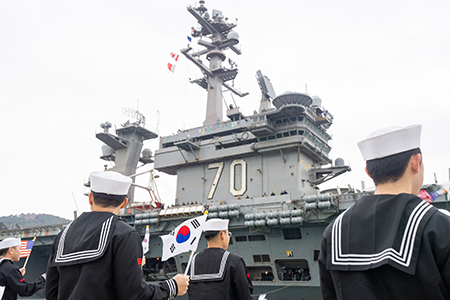"The Arms Control Association’s work is an important resource to legislators and policymakers when contemplating a new policy direction or decision."
North Korea Justifies Nuclear Weapons Expansion
April 2025
By Kelsey Davenport
North Korea threatened to escalate its nuclear weapons program after the United States announced it was sending an aircraft carrier to South Korea for combined, joint military exercises.

The USS Carl Vinson docked in Busan, South Korea, ahead of the annual combined, joint Freedom Shield military exercise, held March 10-20. The South Korean navy described the carrier’s participation as a demonstration of the “permanent and ironclad” U.S. extended deterrence commitment to South Korea.
Kim Yo Jong, sister of North Korean leader Kim Jong Un, called the U.S. decision to send the USS Carl Vinson to South Korea a “provocative” act that shows the “most hostile and confrontational will” toward North Korea.
Kim Yo Jong, who serves as the vice department director of the Central Committee of the Workers’ Party of Korea, said in a March 4 statement to the state-run Korean Central News Agency (KCNA), that U.S. actions offer “sufficient justification [for Pyongyang] to indefinitely bolster up its nuclear war deterrent.” North Korea also will examine its options to threaten “the enemy at the strategic level” and set new records to demonstrate North Korea’s strategic deterrence capabilities, she said.
Kim did not specify what capabilities North Korea may seek to demonstrate or what steps the country may take to enhance its nuclear weapons program. North Korea launched several ballistic missiles before and during the South Korea-U.S. exercise, but the systems did not appear to demonstrate any new capabilities.
South Korea said the March 10 launch likely involved combat-range ballistic missiles that fly very short distances. Before the exercise, North Korea launched a strategic cruise missile. A Feb. 28 KCNA report on the launch said the activities were carried out to inform adversaries about North Korea’s retaliatory capabilities and its nuclear readiness.
After the Freedom Shield exercise commenced, North Korea accused South Korea and the United States of warmongering in a March 11 KCNA statement. The day before, North Korea said the yearly exercise was aimed at practicing a preemptive attack on North Korea’s nuclear facilities. The statement reiterated that North Korea views U.S. hostile actions as a justification for the “radical” growth of its nuclear arsenal.
The combined, joint exercise included more drills than last year but did not include live-fire drills. South Korea and the United States described Freedom Shield as defensive drills aimed at countering a range of North Korean threats emanating from land, sea, space, and cyber domains.
Russia also criticized the combined, joint exercise and said North Korea’s decision to expand its own deterrence capabilities in response is justified. Maria Zakharova, the spokeswoman for the Russian Foreign Ministry, said that Freedom Shield “could trigger a new round of escalation.” She condemned the United States for “saber-rattling” and said there are avenues for peacefully resolving tensions on the Korean peninsula. She encouraged U.S. President Donald Trump to reach out to Kim and suggest “practical steps” to stabilize the situation.
The Trump administration has called for the denuclearization of North Korea and reiterated its support for South Korea, but it is not clear if Trump will try to use his personal relationship with Kim to engage North Korea diplomatically—or if Kim wants to negotiate with the United States.
North Korea appears to be investing in the fissile material production capabilities necessary to expand its nuclear deterrent. International Atomic Energy Agency (IAEA) Director-General Rafael Mariano Grossi raised concerns about North Korea’s fissile material activities March 3. He said there are “strong indicators” that North Korea is preparing for a reprocessing campaign, which removes weapons-grade plutonium from the spent nuclear fuel. Grossi said it appeared that the 5-megawatt reactor at the Yongbyon nuclear complex resumed operations in October 2024, likely after being refueled.
Grossi also described Kim Jong Un’s recent call for expanding weapons-grade nuclear material production a “serious concern.”
In addition to plans to expand its nuclear arsenal, North Korea announced March 8 that it is building its first “nuclear-powered strategic guided missile submarine” and showed pictures of Kim Jong Un inspecting what appeared to be a submarine under construction. It was not clear from the photos how close the submarine is to completion.
North Korea has conventionally powered submarines, but the diesel engines powering those systems are noisy, making the submarines easier to track. North Korea also has tested submarine-launched ballistic missiles capable of delivering a nuclear warhead, but its existing fleet of submarines probably could not carry those missiles.
On his shipyard visit, Kim said North Korea is modernizing its underwater forces to counter the “gunboat diplomacy of the hostile forces,” according to KCNA.
